Mechanics of Journey into Nyx
Table of Contents
Constellation
Strive
Nyx and Bestow
Heroic
Scry
Monstrosity
Devotion and Gods
The plane of Theros is in chaos. Gods and mortals are pitted against each other, and terrifying monsters stalk the land. Heroes strive for glory while new and terrifying constellations take shape in the night sky. Where will you stand?
Constellation
Enchantments with constellation abilities represent the divine constellations that fill the night sky—and now the mortal world—of Theros.
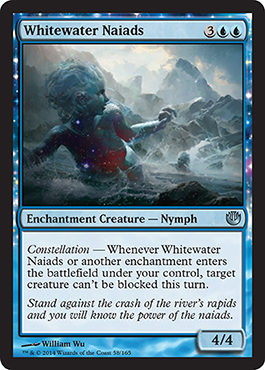
An enchantment's constellation ability triggers every time it or another enchantment enters the battlefield under your control. Most of the enchantments with constellation abilities in Journey into Nyx are enchantment creatures, but not all of them.
Any enchantment entering the battlefield under your control causes each constellation ability of an enchantment you control to trigger, whether it's an Aura, an ordinary enchantment, an enchantment creature, or even a token. (This means that creatures with bestow cause constellation abilities to trigger whether you cast them with bestow or not.)
Strive
A spell with a strive ability lets you pump more mana into it to increase the number of targets.
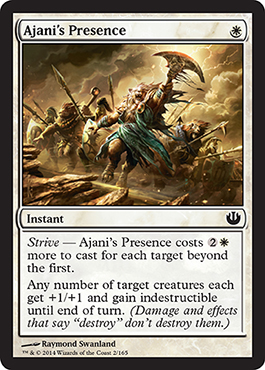
As you cast a spell with strive, you can choose any number of targets, paying an additional cost for each target beyond the first. If you want to cast Ajani's Presence targeting one creature, it costs just [mc]W[/mc]. For each creature you target beyond the first, Ajani's Presence costs an additional [mc]2W[/mc] to cast. So it would cost [mc]2WW[/mc] to target two creatures, [mc]4WWW[/mc] to target three creatures, and so on.
Although you can target any number of creatures with Ajani's Presence, you can't target a single creature with it more than once. As with any other spell that targets, any creatures you control with heroic abilities will trigger when you target them with Ajani's Presence.
Nyx and Bestow
The gods of Theros dwell in Nyx, a starry realm visible as the night sky of Theros. The gods and their servants are infused with the power and majesty of Nyx. Enchantment creatures in the Theros block all have a unique card frame that shows the starfield of Nyx.
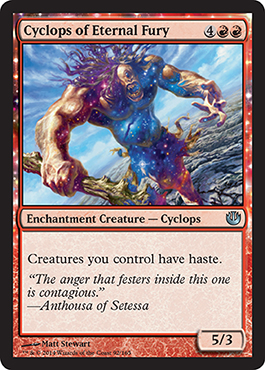
The Nyx frame doesn't have any rules associated with it. It's just a reminder that these creatures are also enchantments. Other enchantments in Theros block use the regular card frame.
Some enchantment creatures in Journey into Nyx have the bestow keyword.
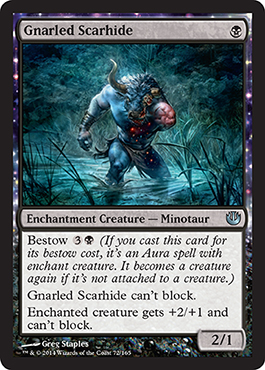
A creature with bestow gives you the option to cast it as an Aura that enchants a creature, granting that creature its power, toughness, and abilities.
When a card with bestow is in your hand, you have two options: cast it normally for its mana cost, or cast it for its bestow cost. If you cast a bestow card normally, it's an enchantment creature spell that resolves and becomes an enchantment creature on the battlefield. Its bestow ability and its "Enchanted creature gets..." text are ignored.
If you cast a card for its bestow cost, it's not a creature spell. Spells like [autocard]Essence Scatter[/autocard] that can target only a creature spell can't target it. Instead, it's an Aura spell with enchant creature, so you have to target a creature to cast it. It can be countered by spells like [autocard]Negate[/autocard] that target only noncreature spells. If the target creature has a heroic ability, the Aura spell with bestow will trigger it, just as any other Aura spell would. Cards with bestow are always enchantments, whether they're Auras or creatures.
If the target creature leaves the battlefield after you cast a card with bestow as an Aura but before the spell resolves, the Aura spell will resolve as an enchantment creature rather than being countered like a normal Aura spell. If the target creature is still on the battlefield when the Aura spell resolves, it resolves as an Aura enchanting that creature.
While it's enchanting a creature, an Aura with bestow grants the creature the abilities and power/toughness changes listed in its text box. If the creature it's enchanting leaves the battlefield for any reason, the Aura immediately becomes an enchantment creature again rather than being put in the graveyard like other Auras.
Although you'll most often want to target your own creatures with your bestow cards, you can also target your opponent's creatures with them. This might be useful, say, if you want to keep a creature from blocking on a crucial turn by casting Gnarled Scarhide on it. As usual, your bestow Aura will stay on the battlefield as an enchantment creature—under your control, not your opponent's—when the enchanted creature leaves the battlefield.
Heroic
A creature with a heroic ability gives you powerful benefits every time you cast a spell that targets it.
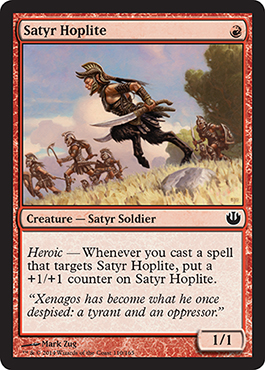
A heroic ability triggers whenever you cast any spell that targets the heroic creature, including a spell that also targets another creature. If a spell targets multiple creatures with heroic abilities—say, because of the strive ability—all of them trigger. Activated abilities, such as equip, do not cause heroic abilities to trigger, nor do triggered abilities such as the enters-the-battlefield ability of [autocard]Breaching Hippocamp[/autocard].
An instant or sorcery spell has a target if it includes the word "target" in its rules text. Each Aura spell also has a target, indicated by its enchant ability, including Aura spells you cast with bestow. Creature spells and permanent spells other than Auras never have targets.
A heroic ability triggers only when the creature's controller casts a spell that targets it, not when any other player does.
Scry
The scry mechanic lets you manipulate your destiny.
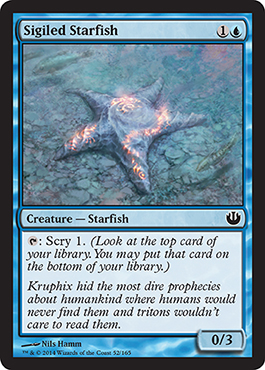
Scry is a keyword action that always has a number associated with it. To scry, look at that many cards from the top of your library, put as many of them as you want on the bottom of your library, and leave the rest on top in any order you choose. When you scry 1, that translates to looking at the top card of your library and deciding whether you want it on the top of your library or the bottom. When you scry 2 or more, you have more options.
Monstrosity
Monsters roam the wilds of Theros, ferociously punishing all who oppose them.
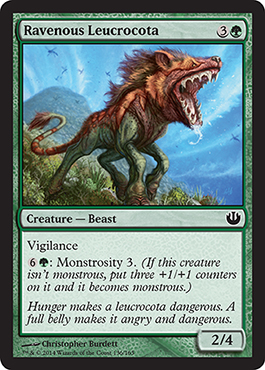
Monstrosity is an activated ability you can activate any time you can pay for it. When it resolves, it checks whether the creature is already monstrous. If it's not, the ability puts a number of +1/+1 counters on the creature and causes the creature to become monstrous. This means that a monstrosity ability doesn't do anything if it resolves for a second time. If a monstrosity ability is countered somehow, the creature doesn't gain counters or become monstrous, and the monstrosity ability can be used again.
Many creatures with a monstrosity ability, such as [autocard]Stoneshock Giant[/autocard] from Theros, have a triggered ability that triggers when the creature becomes monstrous—in other words, when its monstrosity ability resolves for the first time.
[card]Stoneshock Giant[/card]
[autocard]Stoneshock Giant[/autocard]'s triggered ability triggers when its monstrosity ability resolves for the first time. If [autocard]Stoneshock Giant[/autocard] isn't on the battlefield when its monstrosity ability resolves, its triggered ability doesn't trigger.
There are also some cards with monstrosity that gain abilities as long as they're monstrous, such as [autocard]Hundred-Handed One[/autocard] from Theros.
[card]Hundred-Handed One[/card]
Once a creature becomes monstrous, there's no way it can stop being monstrous other than leaving the battlefield. If [autocard]Hundred-Handed One[/autocard]'s monstrosity ability has resolved, it has reach and can block an additional ninety-nine creatures (assuming it's otherwise allowed to block them), even if the +1/+1 counters from the monstrosity ability have been removed somehow (say, by [autocard]Bioshift[/autocard]).
Devotion and Gods
Five gods appear on cards in Journey into Nyx as legendary enchantment creatures with the creature type God. Each God in Journey into Nyx is two colors, completing the pantheon of fifteen gods. A two-color God manifests as a creature on the battlefield once your devotionto its two colors is high enough.
[card]Ephara, God of the Polis[/card]
Your devotion to two colors is the total number of mana symbols that are either of those colors among the mana costs of permanents you control. You don't need to have any particular number of mana symbols of each color; all that matters is the total.
Hybrid mana symbols such as [mc](r/w)[/mc] count toward both their colors but aren't counted twice. In other words, a hybrid mana symbol can only ever add a maximum of one to your devotion to any color or combination of colors, but it adds one to your devotion to any combination of colors that contains either of its colors.
Like the other Gods in Theros block, each of the Journey into Nyx Gods has indestructible, and each one is a creature only if you have enough devotion to its colors. If a God enters the battlefield while your devotion to its colors is less than the required number, abilities that trigger when a creature enters the battlefield won't trigger. If a God on the battlefield is a creature and your devotion to its colors drops below the required number, it immediately stops being a creature. A God can't attack the turn it enters the battlefield unless it has haste, even if it wasn't a creature as it entered the battlefield.
Gods are always legendary enchantments, and their abilities work whether they're creatures or not.

